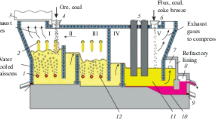The problem of energy consumption in the ferroalloy industry has become an enormous challenge as the cost of energy permanently increases, while the reserves of good-quality raw materials are decreasing. Hence, the valorization of low-quality raw materials becomes necessary under the conditions of keeping the quality of products within the marketable range and low energy consumption. From the history of smelting of manganese alloys, it is known that the priority was always given to high-grade manganese-oxide ores because the quality of the ore has a great influence on numerous important parameters. This was mainly connected with the pyro metallurgical advantages offered by high-grade ores, including high manganese content (minimizing the materials consumption), lower power consumption caused by its oxide nature, and high fusibility. However, in the last 50 years, the ferroalloy industry faces the problem of application of the carbonate ores with an aim to compensate the depletion of the reserves of oxide manganese ores and meet the requirements of steelmaking in which manganese alloys find their primary use. In the present work, we study two manganese ores, namely, pure oxide and carbonate ores. A jones riffle was used for sample preparation. A jaw crusher and zip mill were used to decrease the size of particles, a graphite crucible was used as the container of the ore, and an induction furnace was used for smelting. Various proportions of oxides and carbonates manganese ore were mixed and smelted at 1550°C in the argon atmosphere for 1 h. The investigations of the ores and products were carried out by using the x-ray diffraction (XRD) method, an ICP-OES spectrometer, and a scanning electron microscope with energy dispersive spectrometer. It was shown that a marketable high-carbon ferromanganese can be produced with at least 75% Mn and a slag containing less than 20% MnO. The results obtained for oxide-carbonate blends with 90–10%, 80–20%, 70–30%, 60–40%, and 50–50% ratios met market requirements. However, the results accumulated for oxide-carbonate blends with 20–80% and 0–100% ratios showed that the alloys obtained as a result of smelting contained only 48% Mn and 68% Mn, respectively, despite the fact that the slag contained ≤20% MnО.











Similar content being viewed by others
References
P. O’Shaughnessy, K. J. Kim, and B. W. Lee, “The smelting of manganese carbonate ore,” 10th Int. Ferroalloys Congr., Cape Town, South Africa, Feb. 1–4, 2004, p. 1.
M. Kalenga, M. Tangstad, and X. Pan, “Ferromanganese production: Impact of chemical compositions of raw materials on the energy and materials balance,” Proc. of 13th Int. Ferroalloys Congr., Almaty, Kazakhstan, June 9–13, 2013, pp. 647–653.
T. Tangstad, “Coke bed in Mn-Alloy production,” School of Manganese 2012, Southern African Institute of Mining and Metallurgy.
S. E. Olsen, “The slag basicity concept in the HC FeMn process,” Proc. 9th Int. Congr. on Ferroalloys INFACON 9, Quebec City, June 3–6, 2001, pp. 280–285.
S. E. Olsen and M. Tangstad, “The importance of slag basicity in the production of high carbon ferromanganese,” Proc. 53rd Electric Furnace Conf., Orlando, Fl., Nov. 12–15, 1995, pp. 93–98.
S. E. Olsen, M. Tangstad, and T. Lindstad, Production of Manganese Ferroalloys, SINTEF and Tapir Academic Press, Trondheim (2007), ISBN 978-82-519-2191-6, p. 149.
Yu. S. Рrojdak and Ya. Myanovskaya, “Resource saving in manganese ferroalloy production using low-grade manganese ore concentrates,” Proc. 14th Int. Congr. on Ferroalloys INFACON 14, Kiev, Ukraine, May 31–June 4, 2015, Vol. 1.
V. Marius, S. Hennan, R. Eli, and M. Tangstad, “Properties of Nchwaning and Gloria ore in the production of manganese ferroalloys,” Proc. 13th Int. Ferroalloys Congr., Almaty, Kazakhstan, June 9–13, 2013, pp. 553–565.
V. Kivinen, H. Krogerus, and J. Daavittila, “Upgrading of Mn/Fe ratio of low-grade manganese ore for ferromanganese production,” Proc. 12th Int. Ferroalloys Congr., Helsinki, Finland, June 6–9, 2010, pp. 467–476.
R. J. Ishak, Reaction Kinetics for Reduction of Manganese Ore with Carbon Monoxide in the Presence of Carbon: PhD Thesis, Norwegian Univ. Sci. Technol., Trondheim (2002).
R. J. Ishak and T. Lindstad, “Kinetics of reduction of manganese ores,” in: Metallurgical and Materials Processing Principles and Technology, Vol. 1, Materials Processings Fundamentals and New Technologies, Warrendale, PA, TMS 63073.
J. Kackzorowski, The Boudouard Reaction in Manganese Production: PhD Thesis, Norwegian Univ. Sci. Technol., Trondheim (2006).
Author information
Authors and Affiliations
Corresponding author
Additional information
Translated from Metallurg, No. 2, pp. 23–29, February, 2018.
Rights and permissions
About this article
Cite this article
Sitefane, M., Kalenga, M. On the Possibility of Using Manganese Carbonate Ores in Ferromanganese Industry. Metallurgist 62, 111–118 (2018). https://doi.org/10.1007/s11015-018-0632-z
Received:
Published:
Issue Date:
DOI: https://doi.org/10.1007/s11015-018-0632-z




